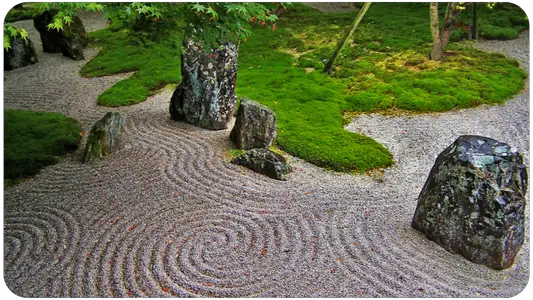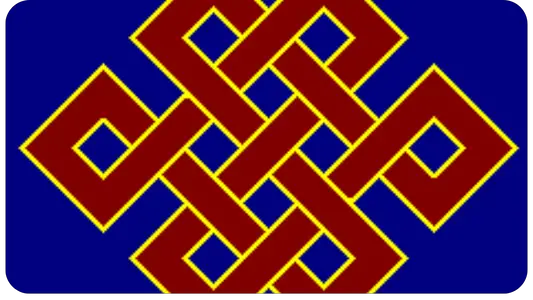Mahayana (Sanskrit महायान mahāyāna, from mahā 'great' and yāna 'vehicle' or 'path', i.e. Great Vehicle or Great Path) is one of the main branches of Buddhism. The generic term Mahayana also includes several currents of Buddhism that are known as independent traditions, such as Vajrayana (Buddhist tantra), Zen, or Amitabha Buddhism.
The division of Buddhism mainly into Hinayana and Mahayana is a conception originating in Mahayana. However, the non-Mahayana schools call themselves differently, including Theravada.
To distinguish
Hinayana and Mahayana
Hinayana literally means "small vehicle" or "small path." "Hina" - meaning "small" - refers to the motivation for the path. From the realization of suffering (First Noble Truth), the practitioner desires to attain salvation from suffering. Whoever develops this motivation for himself (also called "renunciation") is counted as Hinayana according to Mahayana.
This is because the wish relates to only one living being and is thus a small motivation compared to the suffering of the many living beings. Someone who wishes for all beings to attain almsgiving and takes personal responsibility for it has a greater motivation and belongs to Mahayana.
Thus, in Mahayana, the wish for almsgiving refers to all living beings, including one's own person. However, the welfare of one's own person is subordinated to the welfare of all others.
Unfortunate Salvation and Enlightenment
According to the Buddha's "First Turning of the Wheel of Doctrine" - summarized in the Four Noble Truths, the first of which states that to live is fundamentally to suffer (life is suffering) - salvation from suffering, or liberation from suffering, takes place through the extinction of the kleshas (skt., or mind poisons) of greed, hatred, and ignorance as the general psychological basis, so to speak, of all personal suffering and affliction.
With the extinction of these root poisons as the causes of suffering (second Noble Truth) through the practice of the Eight-Limbed Path of Salvation (fourth Noble Truth), the practitioner attains Nirvana, the final liberation from suffering, the possibility of which is asserted in the Buddha's third Noble Truth.
One who has attained and can maintain the state of mind of nirvana or enlightenment has overcome the "obstacles to liberation from suffering" and, according to Buddhism, experiences constant inner peace of liberation. People of this stage of development are called Arhats.
However, according to Mahayana, this liberation or enlightenment does not also remove the "obstacles to omniscience" that only a Buddha has overcome. This omniscience enables the Buddha to help all living beings much better.
According to Mahayana, a Buddha knows the dispositions, karma, and the past, present, and future of living beings, and thus can help them much better than an Arhat who has not attained omniscience.
A distinction is made between the enlightenment of the shravaka (listener), the pratyekabuddha (attains enlightenment without relying on a teaching, that is, out of oneself), and a buddha. Only in the latter enlightenment are the "obstacles to omniscience" removed.
The enlightenment of a Buddha is therefore called "Full Enlightenment" in Mahayana. There are paths for all three types of enlightenment. The path to "Full Enlightenment" is set forth in Mahayana and includes the path of Shravaka (i.e., the Eight-Limbed Path of Salvation).
A person who follows the Mahayana must also attain Nirvana. This he attains on the first level of a Bodhisattva, or the third of the Five Paths, the "Path of Seeing."
Origin of the Mahayana Teachings
The name means Great Vehicle or Great Way and represents the goal of liberating all sentient beings from samsara. The teachings of the Second Turning of the Dharma Wheel by Buddha Shakyamuni were revealed by Nagarjuna and Asanga and taught extensively from about the second century of our era, about 500 years after Buddha's death.
The Mahayana Way has two lineages: the Profound Way lineage through Nagarjuna and the Far Way lineage through Asanga. The former emphasizes emptiness (shunyata), and the latter emphasizes developing the altruistic motivation bodhicitta and the behavior of a bodhisattva.
Followers of the Mahayana say that these teachings had been passed on only in secret until then, because the time for their dissemination had not yet come.
The late emergence of the teachings is also mystically described: Nagarjuna recovered the teachings on emptiness from the Nagas by means of his tantric powers, and Asanga, after twelve years of seclusion and developing real compassion, received the teachings directly from Buddha Maitreya.
According to the view that Buddha directly gave teachings to higher capacity disciples even during his lifetime that were hidden from others, it is described that these Second Turning of the Wheel teachings later became known as the Mahayana tradition and the Bodhisattva path.
The teachings of the First Turning of the Wheel of Dharma, from which the Hinayana (Small Way) tradition developed, are likewise part of the Mahayana and are for the individual's own almsgiving and are also practiced by a follower of the Mahayana.
The teachings of the Third Turning of the Wheel of Dharma (there are a total of Three Teaching Cycles called Wheels) include the Vajrayana (Diamond Vehicle or Diamond Way) and the explanations of Buddha-nature, set forth, for example, in the Uttara Tantra Shastra.
Motivation
Based on the realization of one's own suffering that emerges from the practice of the Four Noble Truths (First Dharmarad), a Mahayana person develops compassion for the suffering of other beings and desires to completely redeem them from their suffering.
The focus of Mahayana is to extend this compassion impartially to all beings - without a single exception - and to increase it steadily until it reaches the depth of a love such as a mother feels for her only, dearest child.
In order to truly help all beings achieve freedom from suffering (enlightenment), the Mahayana practitioner himself strives for the perfect state of a fully awake Buddha. This motivation is called bodhicitta, "enlightenment mind," in Mahayana Buddhism. This mind has two desires:
primary: to help others
secondary: to attain the full enlightenment of a Buddha.
To fulfill these desires, the aspirant develops active bodhicitta and takes the bodhisattva vows in a ritual.
From that point on, he practices the Six Perfections (Giving, Ethics, Patience, Zeal, Spiritual Tranquility, Wisdom) over immeasurable ages (eons), just as the Buddha did. It is said that the Buddha Shakyamuni practiced this path as a Bodhisattva for three world ages (cycles).
This way of the Buddha as Bodhisattva is not only presented in the Mahayana Sutras, but also in the Pali Canon, in the Jataka stories - so it is also accepted by the Theravada followers.
Bodhisattva
One who has developed aspirant bodhicitta and taken the bodhisattva vows (through a ritual) is called a bodhisattva as long as he does not break the bodhisattva ethics. There are 22 types of bodhicitta.
Generally, a distinction is made between the king-like (the bodhisattva first tries to attain enlightenment and then helps all living beings), the boatman-like (the bodhisattva tries to attain enlightenment together with all living beings), and the shepherd-like (the bodhisattva postpones his enlightenment until all other beings have attained enlightenment before him) bodhicitta.
The Bodhisattva Way is presented in Five Paths or Ten Levels. The first of the Ten Levels is entered by a bodhisattva after realizing emptiness (shunyata) and becoming an arhat. This 1st level corresponds to the 3rd path, which is called the "Path of Seeing." More details can be found in the scripture Madhyamakavatara by Chandrakirti.
The Bodhisattva Avalokiteshvara (Sanskrit: "the Lord who hears the cry of the world"), who is often depicted in thousand-armed form, and the Bodhisattva Manjushri are especially revered.
Both, it is said, have developed the shepherd-like bodhicitta and persist at the 10th level of a bodhisattva. The thousand arms of Bodhisattva Avalokiteshvara symbolize his/her ability to act compassionately in incredible abundance. Emphasized in Mahayana are the Eight Great Bodhisattvas:
Avalokiteshvara, Manjushri, Vajrapani, Ksitigarbha, Samantabhadra, Akhashagharba, Sarvanivaranaviskambini and Maitreya. Ksitigharbha plays a major role in Chinese Mahayana Buddhism, for example. Avalokiteshvara is found in female form in Chinese and Japanese Mahayana Buddhism.
Quotes
It says in Tsongkhapa's Lamrim Chen Mo: "Bodhisattvas experience happiness proportional to the effort to seek the welfare of other living beings." And in Bhavaviveka: "Seeing the faults of cyclic existence, bodhisattvas do not stay here. Since they care for others, they do not remain in nirvana. To fulfill the needs of others, they choose to remain in the cycle of being."
Vows
The bodhisattvas' determination to deepen and realize bodhicitta and to dedicate themselves to the salvation of sentient beings and their liberation is affirmed in their vows.
The Eating of Meat
In many, but by no means all, Mahayana schools, the eating of meat is rejected. This goes back to the 8th chapter of the Lankavatara Sutra, where it is explained in detail why bodhisattvas should not eat meat. It states there, among other things:
"For fear of causing terror among living beings, the bodhisattva who practices attaining compassion should refrain from eating meat." However, especially in the Tibetan Mahayana schools, meat-eating is more openly practiced due to climatic reasons.
Teacher-disciple system
A consequence of the Mahayana orientation toward external help is an orientation of disciples toward their teacher or master (Vajrayana and Zen) or the trusting orientation toward Buddha Amida in Pure Land Buddhism.
It is said that the inner guru (sanskr. "teacher") is one's own compassion, and the outer teacher is the one who understands and teaches the prajnaparamita - in the best case, a bodhisattva.
It is important to realize, however, that in Mahayana the teacher accompanies his students on their path to enlightenment without leading them into dependencies. Ultimately, the path to enlightenment must be taken by one's own strength and motivation.
The teacher in Mahayana should embody the bodhisattva activity and possess ten qualities. It is he who helps his disciples attain enlightenment by instructing them in the Buddha's teachings and giving guidance in practice; therefore, in Mahayana he is seen "as a Buddha." The disciple must also be capable and develop a truly pure motivation.
Qualities of the disciple
According to the Indian Buddhist master Aryadeva, a disciple must possess the following qualities: "It is said that one who is impartial, intelligent, and eager is a vessel for the teachings. Otherwise, neither the good qualities of the instructor nor those of the listeners will appear."
Thus, the student must not be sectarian (devoted/attached to one side or tradition or religion and averse to another). He must also have the ability to distinguish between correct paths of good explanations and contradictory paths of bad explanations. Finally, he must possess a truly altruistic motivation.
Qualities of the Teacher
According to the Indian Buddhist master Asanga, whose explanation goes back to Maitreya (Mahayanasutralamkara), a teacher must possess the following qualities:
"Rely on a Mahayana teacher who is disciplined, clear [calm], pervasively pacified [result of trainings in ethics, concentration, and wisdom], has good qualities that surpass those of students, is energetic [consistent joy in the welfare of others],
has a wealth of scriptural knowledge, possesses loving care [teaches only out of love and compassion and not out of self-interest], has a penetrating knowledge of reality [emptiness resp. Shunyata] and skill in teaching students [guiding them and bringing them to understanding]; and who has overcome despondency [giving teachings without tiring, again and again]."
Writings
More important than the Pali canon for the various Mahayana schools are the scriptures translated into Sanskrit. Besides the Tripitaka, these contain in particular various Mahayana sutras. Mahayana followers trace them back to Buddha-Shakyamuni himself.
Theravada followers consider them to be of later origin and accept only the scriptures of the Pali canon as the basis of the teachings. The Theravadins' rejection of the Mahayana scriptures is discussed in detail in the 9th chapter of the Bodhicharyavatara by Shantideva (from verse 49).
He counters this rejection among other things with the fact that the Pali scriptures also originated later (about 500 years after Buddha's death) and consequently one would have to reject the Pali scriptures as well.
Distribution
Today, Mahayana traditions are especially widespread in Vietnam, Japan, Tibet, Bhutan, Taiwan, the People's Republic of China and Korea, and partly also in Mongolia and the Asian East of Russia.
Japanese tradition
Schools of Mahayana still effective today in Japan are:
Amitabha Buddhism, Pure Land, Nembutsu School.
Jōdo-shū
Jōdo-shinshū
Yūzū Nembutsu-shū.
Nichiren Buddhism
Nichiren-shū
Nichiren-shōshū
Nipponzan-Myohoji
Reiyūkai
Risshō Kōseikai
Sōka Gakkai
Tendai-shū
Shingon-shū
Shinnyo-En
Zen
Rinzai-shū
Sōtō-shū
Ōbaku-shū
Zen and Tendai have historically evolved from Chinese Chan Buddhism (Shaolin) and Tiantai zong.
Korean Tradition
Buddhism in Korea was and is fundamentally influenced by Mahayana teachings. Mahayana Buddhism spread throughout the country from the Silla to the Goryo period (from the 7th century to the end of the 14th century) and flourished during the reign of the unified Silla dynasty.
The Joseon dynasty (from the 15th century to the end of the 19th century) did not take over the Buddhist tradition from Goryeo, but increasingly promoted Confucianism, so Buddhism withered away. Today, the old familiar Mahayana Buddhism is still most prevalent in Korea, whose central institution is Jogyejong (조계종 [cogjeʝoŋ]).
Tibetan and other tradition
A further development of the Mahayana means is found in the Vajrayana (cf. Tibetan Buddhism), which supplements the Mahayana bodhisattva path with tantric methods. Four schools still in existence today have developed in Tibet:
Nyingma (also in Nepal, Bhutan and Sikkim).
Kagyu (also in Bhutan, Sikkim and Buryatia)
Sakya (also in Nepal)
Gelug (also in Mongolia and Buryatia)
In China, this form of Buddhism is found under the name Mizong. In Japan, it is transmitted as Mikkyō.
Mantra of Compassion (Vajrayana):
Om mani padme hum (Sanskrit), in Tibetan pronunciation Om Mani Peme Hung, is the mantra of Bodhisattva Avalokiteshvara and has been associated with him since the 5th century.
According to tradition, it has the power to abolish suffering in all realms of samsara and to develop in the practitioner all-encompassing compassion and love for all beings.
According to Vajrayana teachings, Om - composed of A, U and M - represents the body, speech and mind of the Buddha, which are thus invoked.
The entire Buddhist path includes the path of method and the path of wisdom, which must be developed together.
Mani symbolizes the path of method. Mani means "jewel", it can be thought of as a wish-fulfilling "jewel". It represents the so-called white path, which includes virtues such as compassion and the spirit of enlightenment.
Padma means "lotus" and represents the wisdom aspect of the path. This consists mainly of the realization of the ultimate reality, emptiness.
Hum means something that is unseparated and points to the union of Mani and Padma - method and wisdom - because these two should never be practiced separately.
According to the original meaning, Manipadma was a name ("jewel lotus") of the Bodhisattva (here as Manipadme in the vocative). The frequently encountered translation "jewel in the lotus blossom" is not correct.
Mutual influence with European cultures
A mutual influence of the Asian Mahayana and Gnosis as well as Neoplatonism, which flourished at about the same time in the Greco-Roman cultural area and noticeably influenced Christianity, is discussed in the literature.
One possible connecting route here is the Silk Road; many countries in this region that are now Islamic were once Greek and/or Buddhist, with Nestorianism playing a role as a connecting link. However, there is little established knowledge in this area; the tendency to fictionalize history in the Mahayana makes such research difficult. See also Graeco-Buddhism.





